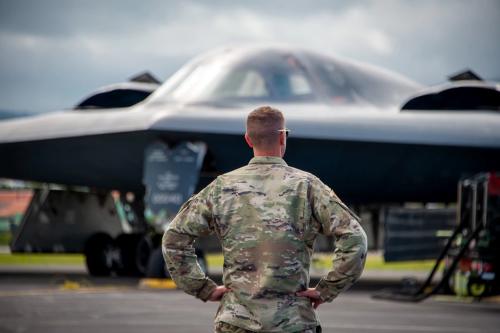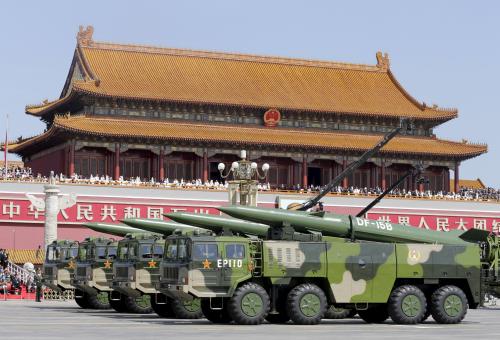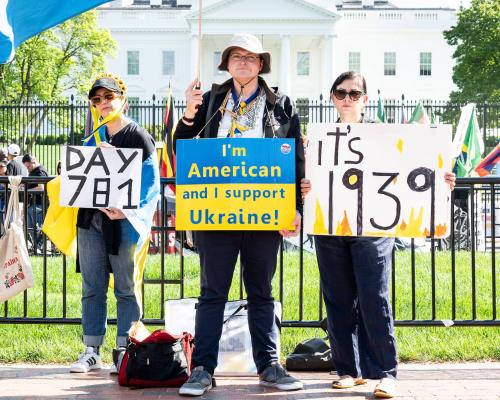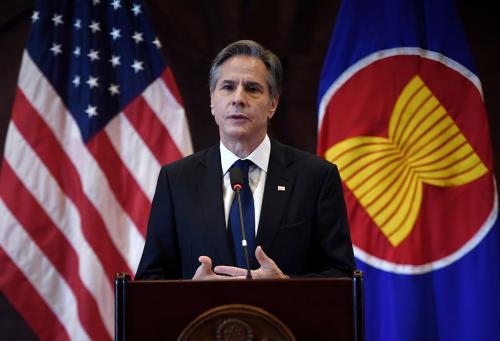Since Russia’s full-scale invasion of Ukraine in February 2022, Americans have heard a lot about military and security assistance, a formerly niche tool of U.S. foreign and defense policy. As the war in Ukraine continues into its third year, the American public has grown more skeptical of providing military support to Ukraine, a wariness largely driven by growing Republican isolationism. Yet military assistance remains a popular tool of U.S. presidents and other policymakers and is likely to play a key role in America’s grand strategy and defense policy after the election this November, no matter which candidate wins.
America’s overall track record on military assistance is mixed. Large-scale U.S. attempts to build partner militaries in Afghanistan and, to a lesser extent, Iraq, cost tens of billions of dollars and ignominiously ended with a collapse of local forces. Previous efforts in Vietnam fared little better. Historically, partners have at times used American weapons to suppress political rivals and commit human rights abuses, especially during the Cold War. More recently, U.S. military assistance to Israel has drawn scrutiny as American weapons are used in Israel’s military campaign in Gaza.
In spite of its varied track record, military assistance, when done right and under the right conditions, can deliver remarkable strategic effects for the United States and its allies and partners, as seen with Ukraine’s success in repelling Russia’s attempted invasion of Kyiv in 2022. With an active land war in Europe far from over, persistent conflict in the Middle East, and rising escalation with China in the Taiwan Strait, the White House will weigh the many costs and benefits of working with and through partner militaries, regardless of which party wins the election.
Unfortunately, after decades of practice and great expenditure, military assistance is still one of the most poorly understood tools in America’s toolkit. We still do not know much about what works, and perhaps more importantly, what does not.
What is military assistance?
U.S. military assistance and arms transfers are more prevalent than a casual observer might expect. Although much of it has stayed out of the limelight until recently, since 2000 the United States has conducted military assistance activities with a remarkable 179 countries around the world, touching tens of thousands of foreign security forces annually. These wide-ranging activities include weapons transfers, training and advising, joint exercises and military exchanges, and professional military education. When all these efforts are added up, using the broadest definition of military assistance (to include sales), the dollar value exceeds well over $200 billion annually.
The lion’s share of this eye-popping number is sales. In the sales process, foreign nations buy weapons directly from the United States, known as foreign military sales ($62 billion in fiscal year 2023), or directly from weapons manufacturers, known as direct commercial sales ($157 billion in FY2023). The sales’ actual delivery can lag significantly behind the notifications to Congress and are often smaller than the amount notified (publicly available information on direct sales in particular remains scarce).
A smaller yet still significant share of this amount is U.S. taxpayer-funded military aid, with roughly $4 billion from the State Department (known as foreign military financing) and another $3.7 billion from the Department of Defense annually (in 2023). While these figures are largely consistent across presidential administrations, military support to Ukraine since Russia’s full-scale invasion in February 2022 has been unprecedented in size, scope, and speed, amounting to over $50 billion. Approximately half of this money is provided via the presidential drawdown authority, which authorizes the Pentagon to draw down its own stockpiles to provide support to a partner nation, with another $19 billion coming through the Ukraine Security Assistance Initiative.
U.S. military assistance often goes by different names, depending on the legal authorities an activity falls under and which department or agency is overseeing or implementing it. These terms include security assistance, security sector assistance, security cooperation, and security force assistance, as well as more niche programs and terms such as security sector governance and defense institutional capacity building.
The Department of Defense commonly uses the term security cooperation while the Department of State uses security assistance. In practice, there is a lot of overlap in roles and responsibilities, with most congressionally allocated funding falling under the Department of State’s legal authorities but executed by the Department of Defense.
A large and unwieldy policy and legal bureaucracy—commonly referred to as the security cooperation or security assistance enterprise—has emerged to oversee, regulate, and execute U.S. military assistance. This entangled web of authorities, permissions, and funding streams makes military assistance incredibly difficult to execute effectively, track transparently, and evaluate.
There are three main commonalities among most incarnations of military assistance:
- The goal of increasing U.S. partners’ military effectiveness, with increased effectiveness serving a U.S. interest, either intrinsically or as a means to achieve a higher-order desired outcome.
- The goal of increasing access to the partner, often in terms of basing and overflight.
- The goal of building defense relationships that promote specific U.S. security interests.
Does military assistance work?
The extent to which military assistance actually achieves these stated goals, not to mention its unintended consequences, is difficult to assess. Existing academic work on the impact of security and military assistance reveals a decidedly mixed bag. Afghanistan, Iraq, and Vietnam are often cited as failures to build effective partner militaries. On the other hand, Ukraine, Colombia, El Salvador, and Greece have been touted as successes. In successful cases, not only has U.S. support helped build military effectiveness, but partners have also remained open to U.S. input and leverage on how such assistance is employed.
Recent research shows that the type of U.S. assistance can also make a big difference, both in intended and unintended outcomes. A handful of scholars and practitioners have observed that lethal U.S. assistance to train and equip partner forces, without accompanying non-lethal assistance, such as advising, often does more harm than good. And in countries where militaries are underdeveloped or deliberately fractured by leaders to protect against possible military coups, not even non-lethal assistance can fully mitigate the negative effects of military assistance.
In our forthcoming book with Yale University Press, titled “War at Arm’s Length: How America Can Build Effective Military Partners,” we argue that two main factors are key to explaining the success or failure of military assistance. The first factor is interest alignment. Though the national security interests and priorities of two countries and their stakeholders are never identical, finding a partner who shares the same goals will greatly increase the chances that the assistance Washington provides will go toward the intended objective.
The second is the partner’s institutional capacity. An effective partner military is more than the collection of military hardware and training programs donors provide. The institutions and governance of the partner military—things like resourcing and acquisition, strategic assessment and policy development, personnel management, and logistics—are critical to the partner’s ability to employ and sustain the military capabilities that Washington provides.
Is it charity?
In short, not really. A lot of the criticism of military assistance to Ukraine is that it is a huge cash giveaway to the Ukrainians. This isn’t surprising since foreign assistance of all kinds is often described as charity. But in the case of taxpayer-funded military aid, American industry and workers are often among the biggest beneficiaries. Foreign military financing, for example, requires countries to use the money to purchase U.S.-made weapons. And the widespread use of the presidential drawdown authority in Ukraine has also been accompanied by tens of billions in replenishment funds that go back to the Pentagon to buy replacements from U.S. industry. Perhaps more importantly, the United States also strategically benefits from this aid, degrading Russia’s military strength and fighting to uphold the U.S.-led global order.
An appealing tool for presidents of all stripes
U.S. military assistance is an enticing tool for presidents and policymakers. It allows them to respond to political and bureaucratic pressure to “do something” with a partner without committing U.S. boots on the ground, and at a relatively low cost. Indeed, military assistance has become the default tool of a wide variety of presidential administrations to achieve myriad defense and national security objectives, from the grand to the small.
Public U.S. military assistance documents and press releases are peppered with lofty aims like promoting global security and fostering shared interests with allies and partners. They are also loaded with more discrete goals like increasing access and influence with partners, as well as coalition building and interoperability. Finally, U.S. goals also often include “softer” objectives such as promoting respect for human rights, individual freedom, and the rule of law.
Because of these appealing attributes, military assistance is likely to remain critical to U.S. grand strategy in the years to come, regardless of who wins in November.
How to improve success rates
Irrespective of which candidate wins, U.S. policymakers responsible for the vast military assistance enterprise would be wise to redouble their efforts to build partners’ and allies’ defense institutional capacity and keep a close eye on interest alignment between the United States and partner countries.
Finding a partner with developed institutions and aligned interests is a best-case scenario—one that’s unfortunately often very hard to find in the real world. Washington should use caution when providing assistance in situations where either factor is low. But policymakers also have two levers they can pull to increase the chances of success.
The first lever is incentives. The United States can condition aid, reward good behavior, and withhold assistance if partner effort lags. The second is institutional capacity building. When interests are aligned and the partner therefore prioritizes the necessary reforms to its defense institutions, Washington can sequence its assistance better. This would mean providing up-front support to help strengthen the governance capacity needed for long-term success prior to the provision of sophisticated equipment.
Though U.S. policy and programming have increased their focus on institutional capacity building and security sector governance support in recent years, the overwhelming share of military assistance still remains dedicated to weapons systems and hardware, rather than the governance structures needed for sustainable effectiveness and the responsible use of force.
As we’ve argued elsewhere, adopting this “institutions first” approach would come with real tradeoffs and is easier said than done. America has legitimate competing security interests across its wide network of allies and partners and faces the need to work with unsavory and autocratic partners, such as Saudi Arabia and Egypt. However, the United States should review and reconsider its current military assistance approach with a swath of countries that are less strategically crucial and face governance and human rights issues, such as Nigeria and Pakistan.
With these types of partners, a more clear-eyed focus on security governance and interest alignment would go a long way toward increasing the rate of success and avoiding replicating some of the worst past failures.
-
Acknowledgements and disclosures
The authors gratefully acknowledge A.J. Dilts for his research assistance, as well as Adam Lammon for editing.








Commentary
Why do US presidents like military assistance?
July 15, 2024